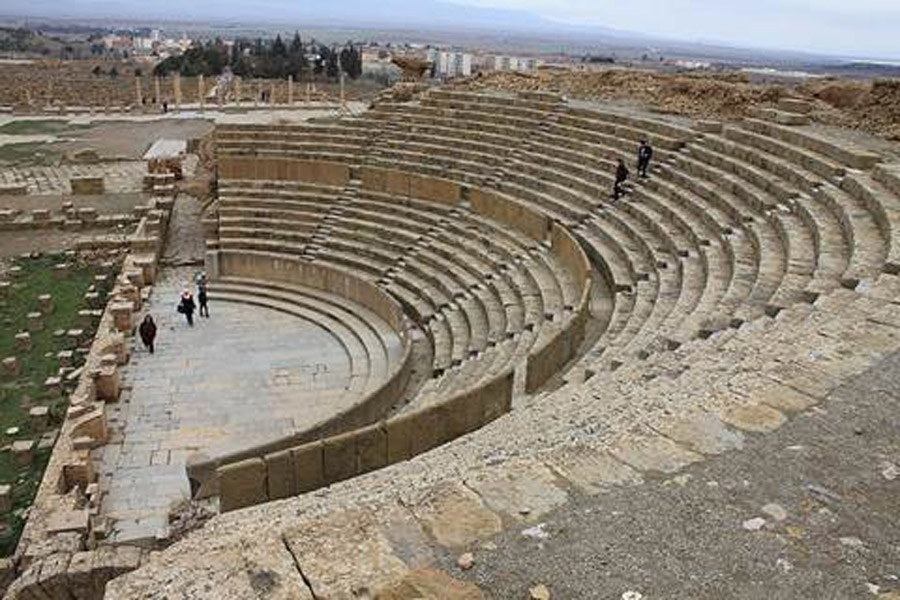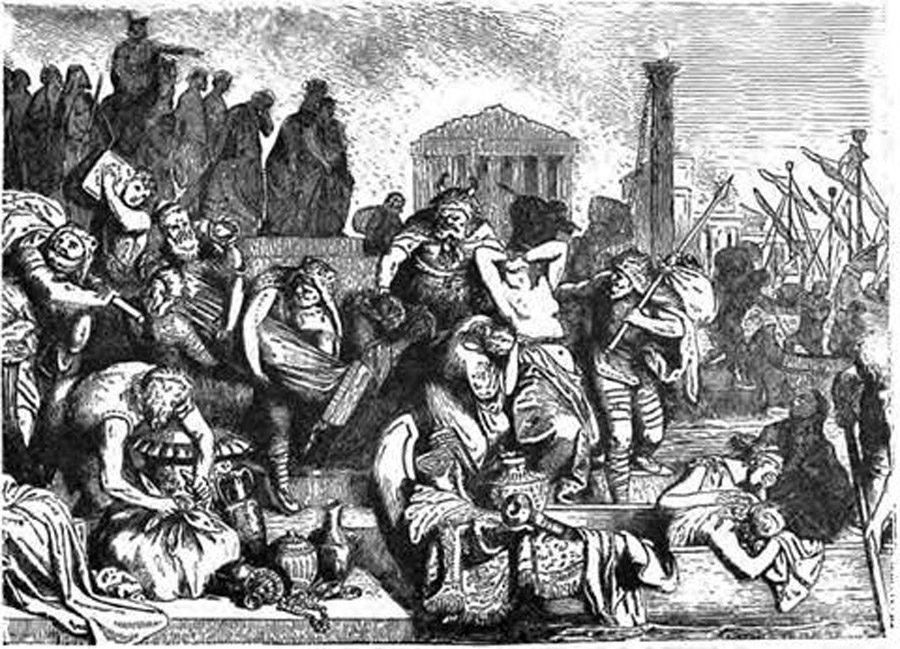The Romans left an indelible mark on Europe. Due to their military conquests, due to their cultural spread, and due to their buildings being of brick and stone, the continent remains littered with Roman ruins today.
This expansion, following the defeat of Carthage, also encompassed north Africa, and it is here today that some unexpectedly well preserved Roman ruins can be found, off the beaten track. One such Roman city, in modern day Algeria, is the city of Timgad.
Located towards the north of the Aurès mountain range, roughly 100 miles (161 km) from the Mediterranean coast, the city was built around 100 AD by the emperor Trajan. Although it was sacked after the fall of Rome, its ruins stand even today in Northern Africa.
But Timgad is unusual in the Roman Empire. Built in territory which had previously been controlled by Rome’s great enemy of the preceding centuries, Carthage, and separated from the European mainland by the sea, it was an outpost in a foreign land.
Primarily a military outpost to protect the African coastline from raiders from the interior, Timgad was also an advertisement, a display of Roman culture. Built to a strict Roman plan, it was a statement: “this is what it means to be Roman”.
Timgad therefore survives as an early attempt to project Roman culture into a foreign environment. Was this city built to attract the peoples of an entirely new continent to the Roman banner?
The City of Timgad
Timgad was carefully constructed in meticulous detail, using Roman urban planning. Designed in order to accommodate a population of nearly 15,000, the city was built in a grid system, walled and located at a natural focal point where six roads intersected.

However, the Romans underestimated the appeal their city would have for both Roman citizens and African colonists. The city grew at a rapid pace and quickly surpassed the original specifications. It seemed the latest in Roman planning was a significant draw, even though most of its citizens would never have seen Rome herself.
The original grid plan is clearly visible today. The Romans called their streets “cardo” if oriented north-south, and “decumanus” if west-east, with the principal street in Timgad belonging to the latter and named the “decumanus maximus”.
This orientation allowed for the maximum amount of natural light to illuminate the main street of the city for as long as possible. Timgad may even show further fine tuning, as the street system is slightly offset from the cardinal points, to take full advantage of natural features surrounding the outpost.
- History of Pompeii: Its Rise, Decadent Heyday, and Destruction
- Roman Concrete: Volcanic Material Created An Empire
At the western end of the decumanus maximus lies the Arch of Trajan, founder of the city. Rising to an impressive 40 feet (12 m) the arch was a statement of Roman power. Constructed in the Corinthian style, it was a testament to Roman military and cultural reach, and the engineering skills of the Roman stoneworkers.

The Romans also filled the city with Roman luxuries. The city boasted four large bath houses, a large public building to act as an administrative center, a public library and a 3,500 seat theatre. The central Capitoline Temple, dedicated to Jupiter, was almost as large as the Pantheon in Rome.
A Wonder from Across the Sea
For the locals, the impact of this alien city must have been great indeed. No settlements existed previously in the area, allowing the Romans to build an idealized city without compromise, from scratch.
Those who saw Timgad for themselves would therefore be faced with the last word in Roman organizational sophistication. Traffic would flow smoothly through the easily navigable grid system. The vast library, a gift from Julius Quintianus Flavius Rogatianus to the people of Rome, spoke of education and learning.
The baths boasted of the Roman ability to manage disease and sanitation, and the easy access to water. And the triumphal arch, the main entrance to the city from the west, was visible along the length of the decumanus maximus.
A Practical Settlement
The construction of Timgad was more than just a statement of Roman power and culture, however. The colonial city was built to home the veterans of the mighty armed forces of Trajan, who would feel connected to Rome even though many would never have seen the great city themselves.
Another purpose was defensive, in that Timgad projected Roman military power into Africa. The Berber tribes who lived in the western and northern regions of the continent would be discouraged from raids by the presence of a Roman colony nearby.
And these practical considerations, and the care with which the city was constructed, ensured it would become a success. Timgad rapidly evolved and became a significant center of trade and commerce, with the residents of the city enjoying prosperity and peace for several centuries.
However, the peace only lasted as long as that of Rome herself. Roman decline allowed other cultures to invade their outlying territories, and by the 5th century, the Vandals had established a presence in north Africa.
Timgad was sacked by the Vandals around 440 AD, only 15 years before Rome herself fell to the barbarians. Although the city was not abandoned, it fell into decline through the rest of the century, mismanaged and neglected by the empire and cut off from her Roman support.

It can be read as testament to the success of the Roman deterrent however that the city survived for decades more. The end would surely come however, and at the end of the 5th century the Berbers, emboldened by the Roman decline, destroyed Timgad.
Excavation of Timgad
In the 6th century, Timgad was partially revived as a Christian city after being conquered by the Byzantines. However, in the 7th century, the city was against sacked by the Berbers, and residents had to abandon the city for good. Left uninhabited, the city was buried beneath the encroaching sands of the Sahara.
This long abandonment helped preserve the city extraordinarily well. After nearly 1,000 years Timgad was rediscovered in such a good state of repair that it became popularly known as the Pompeii of Africa. UNESCO declared it a world heritage site in 1982.
The credit of rediscovering the ancient Roman city largely goes to a Scottish nobleman named James Bruce, then the British consul in Algiers. Following a severe disagreement with his superiors in London, Bruce decided to leave the consulate.
However, he did not return to England. Instead, he teamed up with Luigi Balugani, a Florentine artist, and started a journey across Africa.
Balugani and Bruce reached Timgad on 12 December 1765, the first Europeans to visit the site in centuries. Bruce was taken aback by the ruins of the city of Timgad and made a mention of it in his diary.
He described it as a small town that was full of elegant buildings. On the basis of the history of north Africa known to Bruce, he was confident that they had found the long-lost city of Emperor Trajan.
However, when Bruce returned to London and shared his findings, no one believed him. He went to Scotland and started writing about his discoveries relating to Timgad city. His notes were converted into a five-volume book named “Travels to Discover the Source of the Nile” and were published in the year 1790.
After a century, the new British consul, Robert Lambert Playfair, retraced the steps of Bruce in North Africa, officially rediscovering Timgad in 1881. Subsequent excavations resulted in the designation of the city as a world heritage site in 1982.
Timgad remains an enduring symbol of the history of the Romans. In the design of the city, we can clearly see Roman thinking and urban planning across the millennia.
Free from existing settlement layouts which might compromise the Roman vision, and amazingly well preserved, this settlement showcases how Romans attempted to win the hearts of minds of the local population, and how they chose to present themselves at the frontiers of their empire.
Top Image: The decumanus maximus, the Arch of Trajan and the setting sun. Source: CHAO / Adobe Stock.
By Bipin Dimri